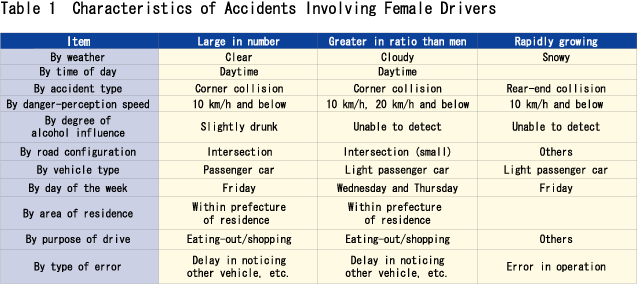 Introduction Introduction |
With the growth index of female drivers surpassing that of male drivers in recent years, the ratio of traffic accidents caused by women is rising each year.
This issue of ITARDA INFORMATION analyzes characteristics of accidents in which female drivers were
the primary party, in an effort to find out how such traffic accidents can be prevented. |
|

|
 |
In this section, traffic accidents involving female drivers are classified under such factors as weather, time
of day, etc., and the component ratio is calculated for each condition. Year-by-year transition is indicated
from 1995 to 2004. The component ratios for conditions under which accidents occurred among male drivers are also given for 2004.
|
 |

|
 |
 Summary Summary
|
Finally, characteristics of accidents involving female drivers are shown in Table 1.
The table indicates aspects of female drivers under each category (e.g. by weather, by time of day, etc.) that are "large in number", "greater in component ratio than male drivers", and "rapidly growing."
|
|

|
Characteristics of Accidents Involving Female Drivers
Many accidents involving female drivers are:
* Corner collisions at small intersections in urban areas during the daytime.
* At low speed, 20 km/h or below.
* While driving for personal purposes, such as eating-out/shopping and visits/pickup and drop-off,
particularly in light or ordinary-size passenger cars.
Also:
* More accidents occur on weekdays than on weekends.
* By type of error, delay in noticing vehicles, etc. is the largest, but errors in operation are on the rise.
* Women have a little trouble driving in bad weather.
The following points of caution can be inferred from the above. (Many of which also apply to men.)
* Be extra careful when confirming safety at intersections without traffic signals.
Do not be satisfied with a single check - double-check and triple-check.
* When in the driver’s seat, concentrate on driving. Do not think of other things.
* If possible, ask an experienced driver to sit in the passenger seat and advise you on any driving problems.
Repeated practice is important for improving your driving skills.
* Avoid driving in bad weather as much as possible. If unavoidable, be more watchful of movements of other
vehicles, pedestrians, etc., especially at intersections, than when driving under fair weather conditions.
* Be kind to other vehicle operators, especially to motorcycle, moped and bicycle riders.
Always drive with an open mind to give way to others, when appropriate.
|
|
Institute for Traffic Accident Research and Data Analysis (ITARDA)
|
|




